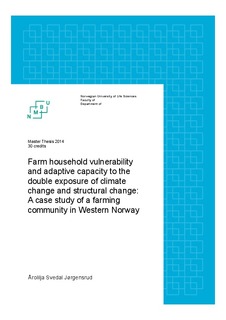| dc.description.abstract | Norwegian agriculture is undergoing rapid structural changes leading to larger farm units and fewer farms, altering the context of farming and the capacity to respond to change. At the same time, climate change is manifesting as seasonal changes, warmer temperatures, and increased precipitation. This study applied a combination of contextual vulnerability and double exposure frameworks to assess current adaptive capacity and vulnerability to the combined effects of climate change and structural change in a rural community in Western Norway. This study employed a triangulation of research methods, covering case study interviews, informal observations and secondary data analysis, to get insight into the process of adaptation and deepen the understanding of how adaptive responses feed back on vulnerability and future adaptive capacity. The objective of this study was to identify to what extent there is a disparity between structural changes in Norwegian farming and building climate adaptive capacity in agriculture. It is assumed that developed countries such as Norway have a high capacity to adapt to climate variability and change. However, this study found that farmers are vulnerable to changing climatic conditions because socioeconomic and political processes of change undermine climate adaptive capacity. Results further suggest that all farmer types, independent of scale, production type, values, and size, are to some degree vulnerable to a diminishing farming community due to the contagious nature of farm closures and lack of understanding among non-farmers. Moreover, this study found that the way in which farmers currently respond to other processes of change affect long-term adaptability of individual farm households and farming communities to future climate change. Policymakers should encourage a diversity of farm sizes rather than focusing on increasing production on a few large farms, particularly in the context of Western Norway where there are certain physical and social limits to the expansion of production that are determined by local contextual conditions such as topography, climate, and the culture of farming. | nb_NO |

